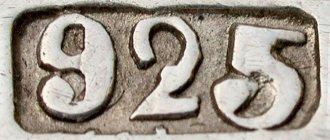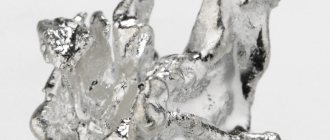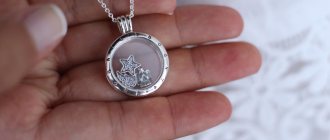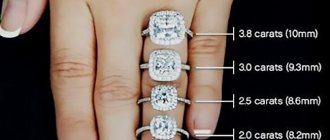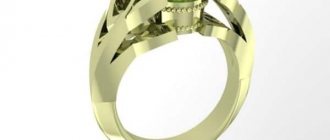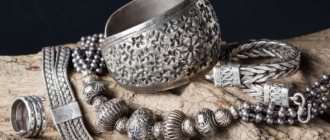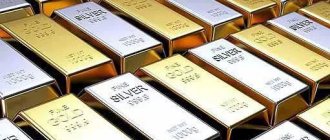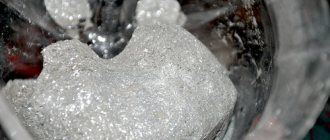Milanti invisible necklace on a fishing line, cubic zirconia pendant
1450 ₽ More details
Milanti invisible necklace on a fishing line, cubic zirconia pendant
757 ₽ More details
Pendants with garnet
Silver was and is loved all over the world and is often preferred to the more valuable gold. Various things have been made from this beautiful light metal for centuries: cutlery, candlesticks, boxes, etc. However, it is most widespread in jewelry. Experienced craftsmen used their imagination to craft precious metal into intricate rings, earrings, bracelets, necklaces and pendants to adorn the bodies of kings, princesses and wealthy citizens. Nowadays, silver is considered a “feminine” metal, since products made from it are worn more by the fair sex. But often silver chains can be seen on men’s necks.
Not everyone can afford jewelry made of pure silver, as they are expensive. In addition, the highest grade metal is impractical. It is soft, so it scratches easily. Openwork jewelry made from it, when worn every day, quickly loses the expressiveness of its relief and is no longer as beautiful as before. Therefore, in jewelry, alloys of silver with other metals (ligatures) are used. Different types of alloys impart hardness to the precious material and increase its wear resistance. Thanks to ligatures, modern jewelers can make silver jewelry using the most complex techniques. What kind of silver alloys are there?
The influence of metals on the quality of the alloy
In the modern world, copper is added to liquid silver as a common alloy; it is believed that these 2 metals interact well with each other.
Small amounts of nickel, cadmium, zinc and other impurities are also introduced into the alloys, with or without copper, which not only improve the quality of silver products, but can also deteriorate them.
So, if the alloy contains 1% nickel, then its strength increases, but with a content of 2.6% the impurity makes the alloy brittle. If more than 9% tin is added to silver-copper alloys, it begins to melt, oxidize and increase the fragility of the alloy. For the same reason, a content of more than 6% aluminum in the alloy is undesirable. Cadmium and zinc reduce the melting point, are resistant to tarnishing in air, are ductile, and are easy to process. If the alloy contains from 15 to 21% zinc, its beneficial properties are negated. Copper in combination with cadmium forms a rather fragile compound. The content of silicon and lead should not exceed more than 1.5% in the silver-copper compound, as it becomes brittle, and phosphorus, sulfur and lead should not be present at all in the precious metal as alloys.
Because of the problems described above, jewelers prefer to add the best metal for it - copper - to pure silver. From 5 to 50% of this golden-pink metal can be injected. With a small copper content in the alloy, the products look great and are close in appearance to pure metal.
The more copper a compound contains, the more its color will differ from pure silver. If the finished jewelry has a slight reddish tint, this is the first sign that the alloy contains 50% copper. If the redness of the product is noticeable, this indicates the presence of more than 50% copper in it. In the markets of Arab countries, jewelry of this type is very often found, and sellers assure gullible tourists that they contain at least 60% silver. Although silver products are cheaper in eastern markets, it is better to buy them in specialized stores. This will serve as a guarantee of the quality of the jewelry and help you avoid buying fakes.
Main characteristics and properties of silver
Pure silver is a silver-colored precious metal with a white tint. It has high electrical and thermal conductivity. Among other metals it stands out for its ductility. It can be subjected to any type of processing (twisting, cutting, polishing, etc.) without destroying the structure.
When interacting with oxygen, it showed a complete lack of oxidation, which is why it was included in the list of precious metals.
However, silver also has negative properties:
- Hydrogen sulfide and iodine contained in liquids react with the metal, and the surface of the latter darkens or a “rainbow” film appears on it.
- Pure argentum has a limited service life, which is why it is usually used together with copper and other impurities in the form of an alloy.
Impurities in silver alloys
Pure silver does not hold the required shape well. To impart the necessary properties, the metal is subject to an alloying process. The following elements are used as additives:
- Copper. The most popular impurity in the alloy is argentum, which gives the product a yellowish tint.
- Platinum. It increases the lifespan of jewelry, but is rarely used due to its high cost.
- Nickel. Rarely used due to health hazards.
- Gold. When alloyed with silver and other impurities it produces white gold.
- Cadmium. It is used only by special order from the client due to its high cost.
Table of alloys (samples)
Depending on the composition of the alloy and the amount of pure argentum in it, the product is marked with a certain grade. Its dependence on the ligature is controlled by the state and is specified in GOST R 51152-98 in the form of a table presented below.
| Try | Compound, % | Impurities, no more, % | |||||
| Silver (Ag) | Copper (Cu) | Lead (Pb) | Iron (Fe) | Antimony (Sb) | Bismuth (Bi) | Oxygen (O) | |
| 800 | 80,0-80,5 | ost. | 0,005 | 0,13 | 0,002 | 0,002 | 0,01 |
| 830 | 83,0-83,5 | ||||||
| 875 | 87,5-88,0 | 0,004 | 0,10 | ||||
| 925 | 92,5-93,0 | ||||||
| 960 | 96,0-96,5 | 0,08 | |||||
How to understand silver samples?
Samples help to find out how many percent of copper is added to the precious metal: their number, consisting of 3 digits, indicates how many grams of pure silver are contained in 1 kg of the alloy. In world jewelry practice, there are specially accepted standards for assaying silver and gold alloys, which manufacturers of precious jewelry must comply with. In Asian countries they produce jewelry masterpieces of 600 standard, although they are not of high quality and quickly lose their appearance.
According to international standards, Ag 720 is considered the lowest purity. Although this alloy has a slight yellow tint, in Russia it is used in jewelry workshops for the manufacture of locks and clasps for chains and necklaces.
Cutlery and dishes are produced from alloys of 750 and 800 samples. Products made from these samples require constant care, since they quickly oxidize in air.
Silver of 830 and 875 standards is suitable as a material for the manufacture of not only cutlery and utensils. It has also found application in the production of decorative decorations for room interiors.
The most famous alloy of silver and copper is sterling. It contains 92.5% precious metal and only 7.5% copper. It is the 925th standard that is most in demand in jewelry. Most of all precious jewelry is made from it. Dazzling sterling is similar in color to pure silver, but is more hard and resistant to tarnishing.
960 standard metal is also used for the production of jewelry. However, such jewelry must be worn very carefully and taken care of carefully. Due to the plasticity of the metal, the products are not durable.
Only 1% of the golden-pink metal contains 999-grade silver. Despite their short service life, Japanese residents willingly buy such jewelry. They believe that pure silver is closely connected with the Moon, which is the abode of deities who are merciful to people, and through wearing this precious metal they want to be closer to them.
How to spot a fake
In Russian jewelry stores, counterfeit silver jewelry is practically never found. However, you can easily stumble upon them when shopping at a fair, market or sales.
To avoid becoming a victim of deception and the owner of an item of dubious quality, you can use a few simple rules.
- If you have a small piece of white chalk, you need to run it over the surface of the product. Contact with silver will cause the chalk to turn black, while counterfeit will have no effect on it.
- To determine the quality of the alloy, you can run a pin across it. If there is no silver in its composition, the resulting strip will be black or red.
The rules described above are highly likely to determine the correct result, but in practice they are of little use, as they damage the surface of the product. This is why other methods are more common when purchasing.
- Hold the product in your fist. If within 1-2 minutes it warms up to body temperature, this is a real precious metal; if it remains cold, it is a fake.
- Press the magnet onto the decoration. Silver will not react to it in any way, unlike iron that imitates it.
What can ligatures be confused with?
Often they try to counterfeit silver alloys by replacing them with similar-looking materials. The most common of them are copper alloys cupronickel and nickel silver. Cupronickel was very famous in ancient times under the name “Warsaw silver”. Pendants and bracelets were made from it, and guns and daggers were lined with it. The material was covered with a thin layer of silver on top, so it was no different from real metal. It cost much less, and not only rich people could purchase products from it.
Nickel silver contains copper, nickel and zinc. Its color and bright shine are so similar to the precious metal that it is even called “new silver.” Nowadays, nickel silver is used in jewelry for the production of clasps and pins for jewelry, but numerous scammers can make rings and brooches from it and cupronickel to sell to gullible buyers at the price of the precious metal. Often there are no samples on such products, which should already give rise to thoughts about the dubious quality of the jewelry. Therefore, it is better not to chase rather cheap “silver”, but to buy it in jewelry stores.
Types of silver
It is generally accepted that silver should be white. In fact, there are many more shades of this metal.
Rhodinated
When rhodium plating, the product is coated with a thin layer of rhodium. It is a metal with characteristics similar to platinum. As a result, the jewelry receives protection from darkening, abrasions and scratches, and its natural shine is enhanced many times over.
Among the disadvantages of this method is the loss of the antibacterial properties of the precious metal. In addition, the shade becomes too unnatural, which is viewed negatively by most lovers of silver jewelry.
Blackened
Blackened jewelry is deliberately aged to give the desired shade. As a result, the simplest product looks like an antique. To achieve the desired effect, oxidation is used - coating the surface with a film of silver oxide. One of the advantages of this method is that the alloy retains its proportions and corresponds to the declared sample.
What is good about Shibuichi alloy?
In addition to the generally accepted tested alloys, there are silver compounds containing a high percentage of copper (from 30 to 75). They do not have huge value in the jewelry market, but are used in the manufacture of interesting jewelry. One such alloy is Shibuichi. It is also called “Japanese bronze” in another way, since it was invented by the Japanese, who widely used the ligature in the production of handles for daggers and knives. Now Shibuichi is used to make beautiful brooches, bracelets, rings and earrings. The word shibuichi means "three quarters" because it contains ¾ copper and only ¼ silver. The natural colors of this alloy are pale pink and yellowish white. The beauty of “Japanese bronze” is that when patinated, the material acquires a variety of shades from light gray to chocolate brown. Thanks to them, the products look unusual and fantastically beautiful. Whatever silver alloy men and women choose, they can be sure that the products will delight them with their appearance and shine for a long time.
Properties of alloys
Silver alloys, in addition to the precious metal, contain impurities that determine the properties of silver:
- nickel: enhances the strength of the metal;
- lead: makes silver brittle when heated;
- tin: with a small content in the alloy, it lowers the melting point of silver, but if there is more than 9% tin, the alloy will become too brittle;
- aluminum: also makes silver brittle;
- zinc and cadmium: lower the melting point of silver, so they are used to make silver solders.
Precious metal alloys are widely used in industrial production. For example, the so-called technical silver (or metal with a purity of 999), mined through refining. This metal is an excellent conductor of heat and electric current, and also has reflective properties, which allows it to be used for the manufacture of high-precision mirrors.
Silver is also included in solders used for soldering jewelry pieces, seams, etc. The metal is also used in the manufacture of silver-zinc batteries and batteries.
Argentum is widely used in medicine, and all thanks to its disinfecting properties, for example, silver effectively disinfects water.
How to determine a sample by density
To determine the sample of a silver product by its density, you need to prepare a scale and a container filled to the brim with water. First, you need to weigh the jewelry and record the result.
Then it is transferred to a container with water and the volume of displaced liquid is determined. When dividing the mass of the product by the volume of water, the density of the decoration is obtained. You just need to compare the result with the sample table.
